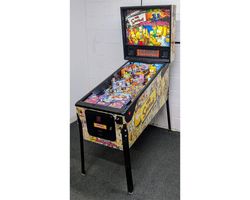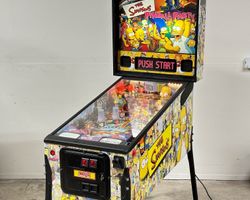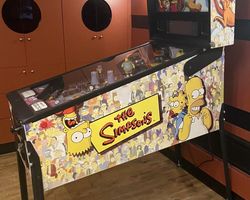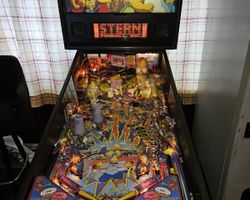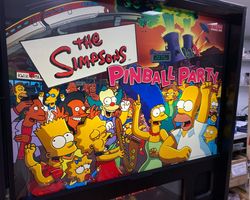The Simpsons Pinball Party
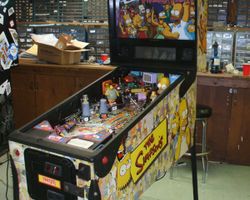
Average Prices: USD $2,600 to $6,500
Produced: Febuary, 2003
Machine Type: Solid State Electronic
MPU: Sega/Stern Whitestar
Players: 4
Design by: Joe Balcer, Keith P. Johnson
Art by: Kevin OConnor, Margaret Hudson, Kevin O'Connor
Dots/Animation by: Mark Galvez
Mechanics by: Ray Tanzer, Wesley Chang
Music by: Dan Forden
Sound by: Chris Granner
Software by: Dwight Sullivan, Keith P. Johnson
In February 2003, Stern Pinball Inc. unveiled "The Simpsons Pinball Party," a delightfully chaotic celebration of one of television's most enduring animated families. Rooted deeply in the heart of Springfield, this pinball table brings to life the antics of the popular series "The Simpsons," making it an irresistible draw for fans and collectors alike.
The design and production process of "The Simpsons Pinball Party" was spearheaded by a talented team, including designers Keith P. Johnson and Joe Balcer, who seamlessly translated the show's essence into an engaging experience. Noteworthy contributors included artists Kevin O'Connor and Margaret Hudson, whose vibrant artwork captured the quirky charm of the Simpson family. The immersive soundscape was crafted by musicians Dan Forden and Chris Granner, featuring custom voice recordings from series regulars Dan Castellaneta, Nancy Cartwright, and Hank Azaria.
Released on February 14, 2003, the machine enjoyed a successful run with 5,900 units produced. It left a significant mark on the market, praised for incorporating both nostalgia and innovation in its design. A fun piece of trivia: when players reach the mystery spot, the game provides a unique twist by activating a reverse flipper mode!
Signature Features and Design
One of the most remarkable aspects of The Simpsons Pinball Party is its collection of intricate toys and features that evoke the whimsical nature of the show. The machine showcases Homer’s moving head, complete with an illuminating lamp, and includes a collection of iconic figures like Itchy & Scratchy, Comic Book Guy, and Bart.
The centerpiece is a three-color digital LED dot matrix "television," reminiscent of the beloved family sofa from the show's opening credits. Adding depth to the gameplay is the multi-tiered playing field that includes a "living room" couch—effectively used as a ball lock for multiball routes.
These features don't merely serve as static elements; they significantly enrich the play by offering multiple layers of engagement and visual storytelling that mimic episodes from the series.
Playfield and Mechanics
The playfield of The Simpsons Pinball Party is a masterclass in design complexity and visual storytelling. It boasts a carefully balanced layout featuring three ramps, each promising a kinetic trajectory that complements its narrative elements. Prominent features include three bumpers, whimsically adorned as nuclear cooling towers to slot into the Springfield aesthetic, and strategically positioned drop targets that challenge players to aim with precision.
A critical element of the layout is the inclusion of five flippers, a choice that opens unpredictable avenues for seasoned players seeking intricate shot combinations. Adding to the excitement is a single captive ball and manual plus automatic plungers, catering to diverse play styles.
The artwork on the playfield, crafted by Kevin O'Connor and Margaret Hudson, is rich with detail and humor, while strategic lighting provides dynamic effects that accentuate key moments throughout gameplay.
Gameplay Dynamics
In gameplay mechanics, The Simpsons Pinball Party elevates the player experience with its robust progression system and engaging scoring framework. The game is renowned for its use of multiballs, offering both three and five ball variations that increase the stakes of each play session.
One standout feature is the machine's variety of unique modes, each themed around iconic episodes or catchphrases. These include objectives like "Daredevil Bart," where players undertake risky feats in the style of Springfield's resident troublemaker. A further highlight is the reverse flipper mode activated through the mystery spot, a challenge that disrupts traditional play and keeps players on their toes.
Players develop diverse strategies, focusing on unlocking multiballs early or exploiting specific modes for high-scoring opportunities. This complexity has ensured the machine's memorability and strategic depth, appealing to novices and veterans alike.
Reception and Legacy
Since its release, The Simpsons Pinball Party has received acclaim from both critics and the pinball community. Celebrated for its inventive design and nostalgic appeal, the machine is often heralded as one of Stern's finest licensed themes. Its strengths lie in its ability to capture the irreverent spirit of the television show while offering a substantial and rewarding gameplay experience.
While some critiques mention its difficulty for casual play, the deep mechanics and layered interactions have cemented its status among enthusiasts. Its legacy endures within the world of pinball, serving as a benchmark for narrative integration in machine design and influencing the development of subsequent themed tables.
 Active Auctions
Active Auctions
 Auction Results
Auction Results
| Cost | Location | Date |
|---|---|---|
| USD $7,500 |  Florida, United States Florida, United States |
10 February, 2025 |
| USD $7,500 |  Florida, United States Florida, United States |
04 February, 2025 |
| USD $9,499 |  United States United States |
26 January, 2025 |
| USD $9,000 |  South Carolina, United States South Carolina, United States |
09 January, 2025 |
| USD $9,000 |  California, United States California, United States |
30 December, 2024 |
| USD $7,700 |  Virginia, United States Virginia, United States |
06 November, 2024 |
| USD $7,000 |  Pennsylvania, United States Pennsylvania, United States |
24 September, 2024 |
| USD $6,000 |  California, United States California, United States |
04 August, 2024 |
| USD $5,995 |  Illinois, United States Illinois, United States |
05 July, 2024 |
| USD $8,400 |  Florida, United States Florida, United States |
15 May, 2024 |


Private Policy · Search Website · Contact Us
All trademarks and copyrighted materials remain property of their respective owners.
All other content copyright 2007 - 2025 Pinpedia.


